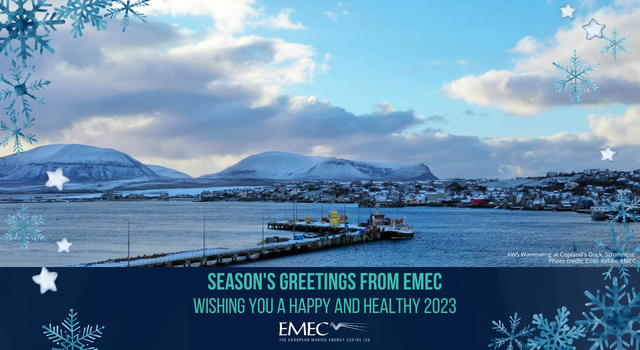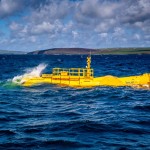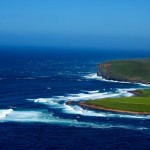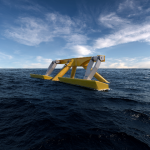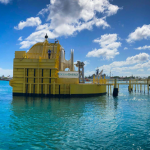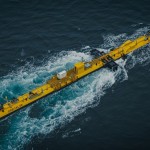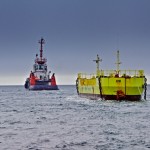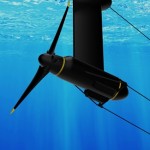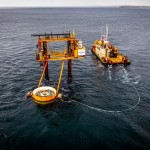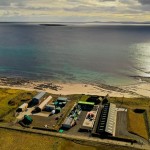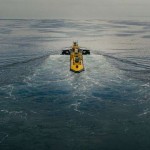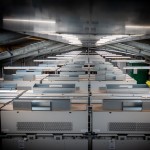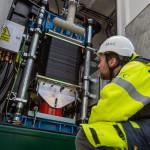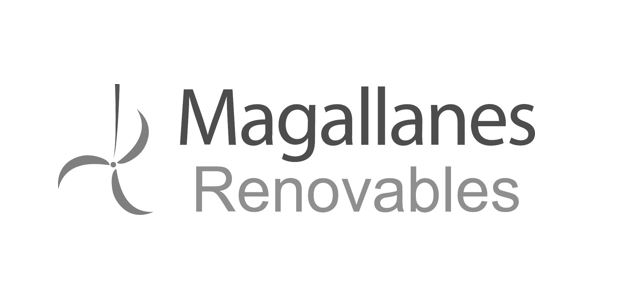Blog: EMEC 2022 review
Energy moved to centre stage in 2022, not because of climate change, but because of the war in Ukraine. The huge rise in fossil fuel prices has fuelled inflation and is leading to widespread hardship. Thank goodness for renewables as the financial impact of the war would have been even greater had we not been developing our renewable energy capacity in the recent past.
But the price rise in all electricity, including that which has nothing to do with fossil fuels, has shown how far from rational the ‘normal’ energy system is. Orkney has long been calling for change to the UK’s archaic system; finally it looks like everybody is waking up to the opportunity to improve the way we generate and distribute energy, albeit in the wake of the huge costs we now face from past decisions and inaction to decarbonise.
So as EMEC enters its 20th year we see the work we and our partners are doing to find ways to harvest energy from our oceans increasingly important. Not only that but the experience of nearly two decades of solid slog has rewarded us with useful insight into a myriad of aspects of the energy system. EMEC’s work on green hydrogen has become increasingly sought after given our on the ground experience and our plans to help floating offshore wind develop are receiving strong support.
It feels like new chapters are starting to be written in the story of transitioning from fossil dependency to true sustainability.
All this is happening against a challenging financial backdrop, but the imperative to decarbonise only continues to increase. We find it really rewarding to hear other people’s stories of progress and it was a great honour to have been asked to become nominators in The Earthshot Prize this year. This imaginative prize seeks to find, publicise and reward organisations who are fighting back against planetary degradation, as well as motivate others to join the fight and make the most of the opportunities of change.
Thanks to pioneering work done in the past enabling renewables (onshore wind, offshore wind, PV etc) to be deployed, we are growing our energy security and working towards a more stable and affordable future. As we enter 2023 we know that the work we are doing now will not only lower bills for those who come after us but give them a chance of inheriting a habitable planet. EMEC see it as a privilege to be allowed to help make this difference.
So the following is a slightly breathless gallop though some of what EMEC, our clients and supporters have achieved together in 2022. In part it gives us a chance to say thank you to everybody who contributed and has supported our work as funders, suppliers, staff and members of the community. None of this would have been achieved without you.
I hope you find this informative, but mostly I hope you find it just a bit inspirational about what can be achieved when we set our minds to it and just try.
We are determined to play our part in building a sustainable future. If you can help us or if we can help you then please let us know.
Enjoy the read and please get in touch.
Neil Kermode
Managing Director
Offshore energy
Wave energy
2022 kicked off with the arrival of AWS Ocean Energy’s Archimedes Waveswing in Orkney. Funded by Wave Energy Scotland, and supported by the Interreg NWE Ocean DEMO project, the 16 kW wave energy converter (WEC) underwent initial shakedown testing at EMEC’s Scapa Flow test site demonstrating deployment, operation and recovery of the device. During its testing programme, average power of over 10 kW, and peaks of 80 kW, were achieved exceeding AWS’s predictions by 20%. When not deployed at the test site, the WaveSwing can be seen sitting on Copland’s Dock in Stromness.
Meanwhile, having completed initial demonstrations of its Blue X WEC at our Scapa Flow site in 2021, Mocean Energy is readying for deployment in Deerness, Orkney, along with a Halo subsea energy storage system designed by Verlume. We will be supporting with instrument deployment, data processing and quality control.
AWS and Mocean share lessons learnt from their real-sea demonstrations at EMEC in this ETIP Ocean and Ocean DEMO webinar.
EMEC updated and extended surveys of the Billia Croo wave test site over the summer to review the position and condition of our subsea cables and observe any others changes to site topography and geology. The new bathymetry, magnetometry and sub-bottom profiling surveys add to our understanding of the sites characteristics which will aid developers as they prepare to deploy.
We’re working with various wave energy developers readying technologies for testing at Billia Croo in the coming years. Marine Power Systems (MPS) signed up to demonstrate a multi-megawatt wave energy array at two berths in 2025/26. The PelaGen WECs will be deployed on a modular floating platform, PelaFlex. EuropeWave has also reserved a berth at Billia Croo as part of the third and final phase of the EuropeWave programme in 2025. The second phase of the programme recently got underway with five wave energy developers progressing a front-end engineering design of scaled prototype devices intended for the open-water trials; three will be selected to proceed to Phase 3 in summer 2023.
- The OE35, the world’s largest capacity floating wave energy device. Credit: OceanEnergy
We also welcomed the launch of the €19.6 million partnership project, WEDUSEA. Co-funded by EU Horizon Europe and Innovate UK, the project will culminate with a two-year grid-connected demonstration of OceanEnergy’s OE35 WEC at our Billia Croo wave test site. In the meantime, we will support the project, feeding metocean, bathymetry and geophysical data into the design criteria for OE35.
This year we’ve also been supporting Quoceant with the development of its Q-Connect system, a modular and adaptable quick connection system for moorings and electrical cables to marine renewable devices. EMEC completed an inspection of the system, testing in accordance with our accreditation and the IEC TS62600-10 standard on assessment of marine energy mooring systems. We also hosted a webinar to share lessons learnt and project progress.
Tidal energy
A great step forward for the tidal stream energy sector came in July when the UK government awarded Contracts for Difference (CfDs) to tidal power for the first time. The CfD scheme is the government’s main mechanism for supporting low-carbon electricity generation, boosting British energy security with cleaner, more affordable, diverse and domestically generated electricity. EMEC is proud to have played a role in arguing for this ring-fenced pot of revenue support for tidal energy. A total of 41 MW of tidal energy projects were granted contracts at a tidal stream strike price of £178.54/MWh.
From this pot, Orbital Marine Power was awarded two CfDs totalling 7.2 MW tidal energy deployments at EMEC’s Fall of Warness tidal test site. Magallanes was awarded 5.6 MW for a tidal energy project at Morlais in Wales, while EMEC alumni SIMEC Atlantis Energy secured 28 MW to further develop the MeyGen site in Caithness.
We’ve had two tidal energy technologies demonstrating at the Fall of Warness site this year. We welcomed the return of the Magallanes ATIR device following maintenance works, while Orbital’s O2 floating tidal turbine has been operating on site since 2021; both have been supported by the Interreg Ocean DEMO project. Meanwhile, California-based tidal energy developer Aquantis, Inc is preparing to deploy its Tidal Power Tug at the Shapinsay Sound test site in 2023.
Since the O2 began operating, Orbital has reported peak power of 2.5 MW. The next iteration of the O2 is being developed as part of the EU funded FORWARD-2030 project which aims to develop a multi-vector energy system combining tidal energy, wind generation, grid export, battery storage and green hydrogen production. EMEC will host the demonstration, facilitating hydrogen production and delivering an environmental monitoring programme. Through 2022 the project has focused on design and procurement activities, with EMEC preparing for acoustic drift surveys to analyse the noise signature of the O2 in 2023.
Other offshore activities include the removal of the OpenHydro turbine from its test platform. A condition assessment is being carried out on the platform as EMEC explores options for repurposing the platform for other offshore R&D projects. Meanwhile, new distributed acoustic sensing and distributed temperature sensing equipment was demonstrated on EMEC’s subsea cables to monitor movement sensitivity and temperature. And a team of researchers, led by the Bryden Centre, Queen’s University Belfast, trialled a novel method to assess bio-physical interactions with floating tidal turbines. Survey methods included unmanned aerial vehicles (UAVs) and water column current measurements alongside visual observations of seabirds and their prey around the O2 turbine. On the first day of the survey the team were greeted by a pod of killer whales travelling through the site!
We also hosted two interns over the summer to support the processing and analysis of environmental data. James Mershon analysed UAV images of marine wildlife at the Fall of Warness, while Hannah Ruskin-Dodd studied collision risk models.
Outside of Orkney, within the Interreg FCE funded TIGER project, EMEC ran ADCP campaigns at PTEC in the Isle of Wight and Raz Blanchard in France and is refining accredited test procedures for the sector.
2021 neared its close with the publication of a promising report looking at the cost reduction pathway of tidal energy, produced as part of the TIGER project. The report documents the global state of the tidal market and presents a cost reduction trajectory taking tidal energy from its current price of £260/MWh down to £78/MWh by 2035. For this to materialise, a huge ramp up of installed capacity is needed over the next decade, which in turn requires long-term policy support and continued ring-fenced funding.
Offshore wind energy
In October, we announced our aspirations to develop a new 100 MW floating offshore wind test and demonstration site. EMEC is aiming to secure a lease for a site ~20 km west of Orkney, further out to sea from our wave energy test facility at Billia Croo. We have concluded concept design, supported by Xodus Group, for a six-berth demonstration site for floating turbines of up to 20 MW rated capacity. Four of the six berths will be grid-connected, while the final two reserved for alternative applications such as hydrogen generation.
With more than 25 GW of floating wind due to be deployed in UK waters over the next 20 years, EMEC’s proposed site would offer a crucial testing ground with representative metocean conditions to those in ScotWind and Celtic Seas.
This year we also kicked off a major research and innovation (R&I) programme with the West of Orkney Windfarm. Rights to develop the 2 GW windfarm 30 km off the west coast of Orkney were secured in January with an aim to start producing power by 2030. The R&I programme is tasked with identifying ways to deliver the project more efficiently and cost effectively covering a broad range of challenges including the exposed location, environmental impacts and remote operations.
Once built, the windfarm could deliver renewable power to the Flotta Hydrogen Hub, a proposed large-scale green hydrogen production facility in Orkney for which plans are being developed by Offshore Wind Power Limited and partners, with support from EMEC.
Meanwhile, the CleanWinTur project continued researching practical solutions to minimise the impacts of biofouling on offshore wind structures. Several technologies have been trialled to deter biofouling on ladders including ultrasonic transducer, UV and thermal systems. More on that in the new year.
Building on 20 years of experience operating offshore test sites, alongside our drive to help develop innovative sustainable solutions to tackle climate change, floating offshore wind is a natural next step in the evolution of EMEC. Floating wind poses a significant opportunity for Orkney; BBC Radio Orkney discusses the opportunities and public opinion in its latest Energy Islands broadcast.
Green hydrogen
The potential of hydrogen technologies has gained significant attention since the UK government published its hydrogen strategy last year. The initial goal was for 5 GW of hydrogen production by 2030; the new British Energy Security Strategy doubled that to 10 GW, with at least half of this from electrolysis. The Scottish Government released its Hydrogen Action Plan this month, reconfirming ambitions for 5 GW of installed renewable and low-carbon hydrogen production capacity by 2030. EMEC continues to work hard to identify opportunities and progress efforts to support these plans and explore where green hydrogen can best play a role in a net zero economy.
Renewables integration for hydrogen generation and storage
Developments at EMEC’s Caldale site on Eday continued apace this year with partners and subcontractors working with EMEC to install and commission equipment onshore. EMEC’s 670 kW electrolyser is being recommissioned and has produced small amounts of hydrogen as part of the commissioning process. Alongside this, we welcomed the arrival of 48 vanadium flow batteries, supplied by Invinity Energy Systems, which have been installed and energised in EMEC’s new energy storage building. Funded by The Scottish Government, the 1.8 MWh battery system aims to ‘smooth’ tidal power by storing it during high generation periods and releasing during low generation periods to enable the continuous production of green hydrogen from tidal energy. We look forward to demonstrating the integration of these technologies in the new year.
Incorporating these site developments, the Interreg NWE ITEG project will support the demonstration of the integrated tidal, battery and hydrogen solution, with a new energy management system designed to determine whether tidal power is routed to the grid or used for hydrogen production. A series of ITEG webinars provide project and hydrogen sector updates.
We are collaborating with H2GO Power on two projects demonstrating hydrogen storage and artificial intelligence (AI). The HyAI 2 project aims to trial an AI software platform to optimise production and storage by combining historical and forecasted data on weather, renewable generation sources including wind and tidal, as well as hydrogen storage capacity and electricity prices. The project builds on initial modelling and simulations using real-word data from EMEC’s site. The second project, SHyLO (Solid Hydrogen at Low pressures) aims to install and demonstrate H2GO Power’s 1 MWh modular low-pressure hydrogen storage solution and will be integrated with the HyAI cloud platform and EMEC’s network of hydrogen assets to assess performance and commercial viability. Commissioning of the solution is expected to commence in 2023.
EMEC also welcomed a new client, Zero Host, to Eday. Zero Host’s data centre is in the process of being installed in the energy storage building and aims to reduce curtailment of the Eday community wind turbine. More on that in 2023.
Demonstrating hydrogen logistics and use
The BIG HIT (Building Innovative Green Hydrogen Systems in an Isolated Territory) project ended in 2022. Lessons from demonstrating kit within this project, and other pilot projects such as Surf ‘n’ Turf, are proving invaluable in paving the way for innovation and development in the sector.
As a legacy of these trailblazing projects, Orkney is one of the first locations to deploy assets across the full hydrogen value chain and is widely recognized as one of the first ‘hydrogen territories’ in Europe. By exploring integrated approaches to hydrogen production, storage, transportation and end use, significant learning was gained on the deployment, maintenance and operation of assets, with many operational challenges faced throughout the project. Learning such as electrolyser stack design, system integration and material selection has fed into EMEC’s site developments on Eday and supported wider industry and technology development. Additionally, we’ve developed a deeper understanding of hydrogen logistics enabling us to develop standard operating procedures for transporting hydrogen via road and ferry.
Our Operations Technician, Jerry Gibson, provides some insight into this learning in the Hydrogen Territories Platform webinar.
To support the transportation of hydrogen from Eday to R&D applications across Orkney and the UK, EMEC was awarded funding from the Scottish Government to secure two additional mobile hydrogen storage trailers. The trailers will improve the logistics and support new projects, positioning EMEC to expand hydrogen production in the coming years.
Aviation
2022 saw new opportunities for low carbon aviation demonstrations. The Sustainable Aviation Test Environment (SATE), based at Kirkwall Airport, was given a funding boost as part of the Future Flight Challenge. SATE 2 aims to establish an unmanned aerial vehicle (UAV) hub-and-spoke delivery network and will conduct demonstration flights of technologies including a hydrogen-electric regional aircraft and a drone flight from Scotland to Norway. EMEC will support the flight trials in the project, supplying green hydrogen and the use of a bespoke hydrogen refuelling system compatible with an airport environment.
With funding support from The Scottish Government, EMEC installed a hydrogen-powered combined heat and power (CHP) unit at Kirkwall Airport, supported by our sub-contractors. Hydrogen generated in Eday was delivered to the airport to support the commissioning process; kit will be fully trialled next year to meet some of the heat and power requirements of the airport building, producing only water vapour as a by-product.
Outside of Orkney, EMEC continue to support the HyFlyer II project with our hydrogen production and refuelling system at ZeroAvia’s R&D facility at Kemble Airport. Hydrogen produced on site has supported the ground testing of ZeroAvia’s Dornier 228 test bed aircraft, retrofitted with a hydrogen-electric powertrain. The first flight tests are expected to take place in the new year.
Hitting the headlines at the end of the year, EMEC provided green hydrogen produced in Orkney to fuel the ground test of a converted Rolls-Royce jet engine. The test took place at an outdoor test facility at Boscombe Down, UK. A video of the ground test can be viewed here.
We expect synthetic fuels will have a large part to play in aviation in the future. Listen into Pete Oswald on BBC Radio Orkney (~48 min 30 seconds in) explaining how green aviation fuel created with the help of EMEC was used by the RAF.
Maritime transportation
Being based on an archipelago, the maritime sector continues to be an area of strategic R&D interest for EMEC. We are investigating the role green hydrogen may have, either as a fuel or a building block to produce derivative fuels, in decarbonising the sector.
The HIMET (Hydrogen in an Integrated Maritime Energy Transition) project set out a programme of test and demonstration activities exploring maritime decarbonisation. EMEC led the consortium focussed on trials of low-carbon technologies for vessels at sea and shore-side solutions. In March, a hybrid solar PV and hydrogen engine was deployed at Hatston Pier in Kirkwall to power welfare facilities at the cruise terminal. This was used by shoreside crew welcoming cruise passengers to Orkney over the summer season and is expected to be redeployed in 2023. Feasibility studies assessing microgrid solutions and hydrogen and ammonia fuels for maritime use were also conducted. Unfortunately, due to tight project timelines and global supply chain issues, it was not possible to complete all planned demonstration activities within the duration of the project itself, however learnings and recommendations are being fed into future maritime decarbonisation projects.
EMEC are also part of three consortia following the second funding round of the Clean Maritime Decarbonisation Competition. Due to kick off in January 2023, the projects will conduct technical and economic feasibility studies associated with development and real-world demonstration. For example, project ZEPHyr (Zero Emission Hydrogen Powered Hovercraft) is an 8-month feasibility study aiming to de-risk the barriers to zero-emission hovercraft operations.
Local content, global impact
Local impact
Orkney is at the heart of EMEC’s DNA. We are proud to be based in Orkney and a large focus of the work we do considers how to create local impact – economically and socially as well as positioning the islands at the centre of the renewable energy revolution. Our PhD researcher, Lara Santos, is exploring the justice dimensions of emerging energy technologies particularly focused on ocean energy and green hydrogen in island communities. It’s shaping up to be a fascinating body of work.
EMEC aims to ensure the work taking place here generates ongoing local benefit. In 2021/22, 45% (£3.2 million) of EMEC’s total expenditure was spent in the local Orkney economy; since 2005, over £30 million (50% of total expenditure) has been spent by EMEC locally. As EMEC diversifies, we continue to grow with over 80 members of staff now working at EMEC, 75% of whom live and work in Orkney. We’re actively recruiting various positions across the company and have recently opened our internship programme for 2023 intake.
We strive to be a fair and equitable employer, creating a vibrant and inclusive working environment for our team. Our mean gender pay gap is 11.8%, which has halved from 23% back in 2019; we are actively working to reduce it further. We proudly joined the International Women in Engineering Day and #BreaktheBia campaigns in 2022 and held imposter syndrome workshops across the company.
In 2022 we sponsored local events such as the Folk Festival and the Orkney Blues Festival as well as local clubs like the Orkney Amateur Swimming Club and the Stromness Pipe Band. We have also donated prizes for fundraising, for example to Stromness Academy for their Christmas fair and to the Holm Sailing Club for a new safety boat.
Our employees have been engaging with young people on green career paths and opportunities in a net zero future. Activities this year have spanned STEM talks at Kirkwall Grammar School and Stromness Academy, speaking to students at the Orkney Careers Fair and working with Glasgow Science Centre on wider STEM engagement opportunities.
A highlight of the year was the Orkney International Science Festival. We held open days at our Billia Croo wave test site and hydrogen fuel cell in Kirkwall, attracting over 50 locals and tourists to each site. We held our annual science festival update in the Stromness Town Hall alongside our clients AWS and Orbital, with ~70 people joining us for the evening talk, and engaged with a younger audience at the Family Day, with a hydrogen demonstration car, marine soundscapes game, and science-fiction writing competition about “energy futures”.
We’re always interested in connecting with new audiences and excited to see the creative sectors being inspired to communicate our work through different media. In the summer, poet Ingrid Leonard spent a two-week residency at EMEC following which she published a collection of poems, ‘What the Waves Make’. And we were delighted to hear about the release of local band Fara’s new album titled Energy Islands, with EMEC credited as part of their inspiration inside the front cover.
Global collaboration
Following travel restrictions being lifted, we were delighted to welcome new and returning visitors back to Orkney including several members of Scottish and British parliament: Michael Matheson MSP, Lorna Slater MSP, Richard Lochhead MSP, and Rt Hon Greg Clark MP. We’ve hosted visitors from countries including Japan, Malta, Norway, Canada and New Zealand and facilitated a highly engaging visit from Crown Estate Scotland Board members.
We were delighted to get back on the conference circuit this year, crucial for connecting with colleagues in the industry and sharing knowledge and lessons learnt. Highlights include exhibiting alongside the Orkney and Highlands and Islands supply chain at All-Energy in Glasgow, special thanks to Scotland’s First Minister for popping past for a chat. The First Minister also visited us at the Royal Highland Show to discuss the innovative projects that are pioneering a low carbon future in Orkney and across Scotland.
The global ocean energy sector then converged in San Sebastian in Spain for ICOE (the International Conference on Ocean Energy). Prior to ICOE, we co-hosted the International WaTERS workshop with EVE and BiMEP, welcoming 34 delegates from 17 ocean energy test centres for two days of workshops sharing challenges and learning with one another.
In the spotlight
A richly deserved award was made in June, when our Chair, Andrew Mill, was awarded an OBE for services to the environment and the community in Orkney. Andrew was at the helm of EMEC when the company was set up in 2003, acting as managing director until 2005, and returned as Chair in 2014. The OBE is well earned recognition of his hard work and dedication to renewables through his time with EMEC and the impact that’s had as a significant employer in Orkney.
EMEC staff were also well recognised this year, with Caron Oag, EMEC’s Senior Marketing Officer (Hydrogen) taking home the Professional Service Award at the Scottish Renewables Young Professional Awards. Meanwhile at ICOE, EMEC’s EngD student, Alyona Naberezhnykh, was awarded first place in the poster competition for her poster ‘Can we trust turbulence models?’, while Luke Evans took first place in the photography competition in the marine environment category.
EMEC were also highly commended for the Pioneer award at the British Renewable Energy Awards.
Pioneering a new low carbon future
EMEC strives to support the development of solutions to combat climate change and in 2022 we became an Official Nominator for The Earthshot Prize. This followed a visit from the Prince and Princess of Wales, then Duke and Duchess of Cambridge, in 2021. The Earthshot Prize is the most prestigious global environment prize in history, aiming to find new solutions to the world’s biggest environmental problems. As an Official Nominator, we have launched an open call seeking innovations that will help repair and regenerate the planet. Applications deadline is 12 noon, Tuesday 17 January 2023.
2023 marks EMEC’s 20th anniversary and we will be showcasing progress made to date in developing an ocean energy sector and exploring new energy systems and energy vectors. As well as the demonstration and R&D activities mentioned above, we will be sharing lessons learnt from the ReFLEX Orkney project addressing the challenges in delivering a whole energy systems approach for smart local energy systems. And we look forward to sharing plans for the Islands Centre for New Zero, one of the key initiatives being established as part of the Islands Growth Deal aiming to establish Orkney, Shetland and the Outer Hebrides as lighthouse communities in the transition to net zero.
Looks like we have yet another busy year lined up as we work with our partners to continue pioneering a low carbon future.
Wishing our community, clients, project partners, suppliers, funders, and supporters from around the world a very merry Christmas and a happy and healthy 2023!
